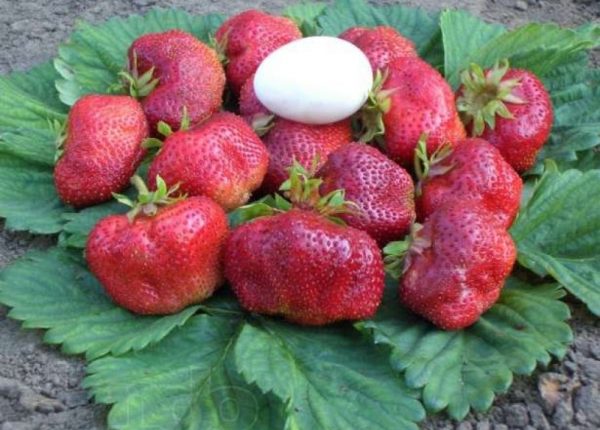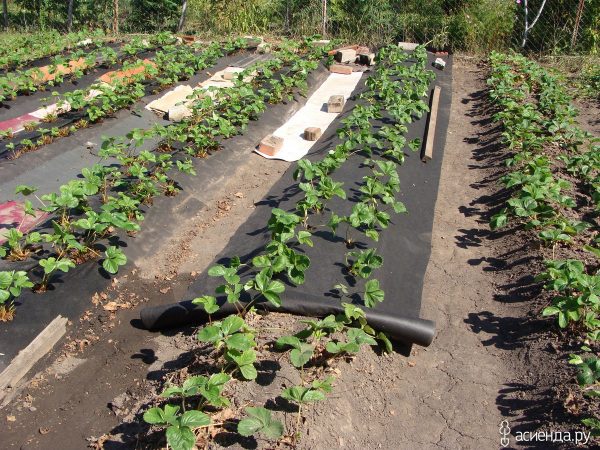You have planted a large-fruited strawberry variety. Such varieties require intensive agricultural technology. Under normal conditions, they also bear fruit. There will be a lot of berries, tasty, sweet, but small. In order to During the entire ripening period, the berries grew large; special care was required for the plantings.

Pandora strawberries grow larger than a chicken egg.
Growing large-fruited strawberries
In order for strawberries to grow large, the following conditions must be met:
1 CONDITION. To get a good harvest, the strawberry plantation should be kept for no more than 3-4 years, because it ages faster than all berry crops. Modern varieties bear fruit most abundantly the first time if planted in August. The maximum harvest of strawberries is obtained in the 2-3rd year. Strawberries in the third year of planting produce the first normal, large berries, but from subsequent harvests the berries become smaller and do not develop. The stems (horns) age, from the flower buds of which a harvest is formed in the second half of summer. To enhance the formation of new horns, old horns are removed in early spring to encourage the formation of young horns with new flower buds.
2 CONDITION. Use strawberry varieties for planting that are adapted to your climate and are sufficiently winter-hardy.

Planting strawberries.
3 CONDITION. In order for the ovaries to develop well and the berries to be large, it is necessary to maintain spatial isolation (distance) between varieties. With mixed thickened planting, the berries develop poorly.
4 CONDITION. The main reason for the uneven development of berries is improper care of strawberries. First of all, this is improper fertilizing. It should be carried out in a balanced manner, observing the required dosage, during the period of greatest need for nutrients.
Fertilizing large-fruited strawberries
First feeding carried out in early spring, when the roots work weakly in cold soil and the plants lack nitrogen. Before the first spring loosening, add ammonium nitrate or urea (20 g) per 1 square meter. m or a matchbox for 10 liters of water. Good results at a temperature of 10-12 degrees are obtained by treating strawberry bushes with plantafol or master complex fertilizer.To relieve stress (temperature changes) and absorb nutrients by plants, add megafol (25-35 ml per 10 liters of water) to the planta-fol working solution - this is per hundred plantings or 2.5-3 ml per 10 square meters. m.
If digging was not done in the fall after the first pruning, a matchbox of azofoska + 2 cups of ash per square meter is added for spring digging. m. This fertilizing is needed for leaf growth and fruiting.

Fertilizing strawberries
Second feeding carried out during the budding period for the formation of inflorescences and leaf growth. It is required because increases the yield by 1.2-1.5 times. Use plantafol (30-35 g per 10 liters of water) or aquarin-super (20 g). Aquarin-super is immediately absorbed by strawberry leaves, flowering is enhanced and berries are actively set. If these drugs are not available, you can root fertilize with azofoska (2 matchboxes per 10 liters of water).
Third feeding - at the beginning of flowering, 10 days after the second feeding is carried out to stabilize flowering and increase the size of the berries of the second and third harvest. Use mullein (1:20) + 1 matchbox of nitrophoska per 10 liters of water or spray the leaf with planta-fol (5:15:45) with boroplus (15-20 ml per 10 liters of water).
Fourth feeding (10 days after the third) is carried out to stimulate the formation of flower stalks for the next year and for better overwintering. Spray the plantation with aquarin-fruit fertilizer solution (20 g per 10 liters of water) or carry out foliar feeding with diammo-fosco (2 matchboxes).
Post-harvest care
After the berry harvest in July and August, in hot, dry weather, the plants stop growing. Old leaves affected by diseases are colonized by mites. Such leaves are mowed after harvesting. The area under the strawberries is freed from leaf spot and pests.

Pruning strawberries after harvest.
- After mowing a meter of row spacing, autumn fertilizer (40 g per 1 sq. m) or nitrophoska (40-60 g per sq. m) is scattered under digging.
- Against ticks and diseases, treat strawberry bushes with a cocktail of Fufanon + Ridomil + Art. spoon of urea).
- You can add superphosphate separately - 30-40 g + potassium sulfate - 20 g + ammonium nitrate - 10 g - per 1 sq. m.
- In November, mulch the soil around the plants with humus.
In August and September, strawberries require careful care, because... At this time, leaves, roots, tendrils grow intensively, and fruit buds are laid for next year's harvest. In mid-August, for these purposes, as well as for better preparation for winter, carry out additional root feeding with nitrophoska or other complex fertilizer. After watering and fertilizing, loosen the soil shallowly with a rake. At the same time, it is necessary to destroy the mustaches if they are not needed for growing seedlings.
Continuation of the topic:
- Strawberry Alba: variety description
- Strawberry Gigantella Maxim: description of the variety
- The best varieties of strawberries with photos and descriptions
- Strawberry diseases and treatment methods
- Caring for strawberries from spring to autumn

 CUCUMBERS NEVER GET SICK, I'VE BEEN USING ONLY THIS FOR 40 YEARS! I SHARE A SECRET WITH YOU, CUCUMBERS ARE LIKE THE PICTURE!
CUCUMBERS NEVER GET SICK, I'VE BEEN USING ONLY THIS FOR 40 YEARS! I SHARE A SECRET WITH YOU, CUCUMBERS ARE LIKE THE PICTURE! You can dig a bucket of potatoes from each bush. Do you think these are fairy tales? Watch the video
You can dig a bucket of potatoes from each bush. Do you think these are fairy tales? Watch the video
 How our fellow gardeners work in Korea. There is a lot to learn and just fun to watch.
How our fellow gardeners work in Korea. There is a lot to learn and just fun to watch. Eye trainer. The author claims that with daily viewing, vision is restored. They don't charge money for views.
Eye trainer. The author claims that with daily viewing, vision is restored. They don't charge money for views. A 3-ingredient cake recipe in 30 minutes is better than Napoleon. Simple and very tasty.
A 3-ingredient cake recipe in 30 minutes is better than Napoleon. Simple and very tasty. Therapeutic exercises for cervical osteochondrosis. A complete set of exercises.
Therapeutic exercises for cervical osteochondrosis. A complete set of exercises. Which indoor plants match your zodiac sign?
Which indoor plants match your zodiac sign? What about them? Excursion to German dachas.
What about them? Excursion to German dachas.